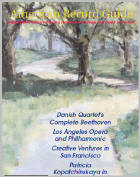Texte paru dans: / Appeared in: Alpha |
|
|
Outil de traduction ~ (Très approximatif) |
|
|
Reviewer: Charles
Brewer This recording contains, in addition to a cantata about a rejected lover, two very different perspectives on the mythical story of Ariadne and her love for Theseus, who later abandoned her on Naxos. The subject of Ariadne was enticing for many composers in the 17th and 18th centuries, perhaps beginning with Claudio Monteverdi’s Arianna in 1608 (lost except for its famous lament) and continuing in operas by Porpora and Handel. The fascination for this subject by these earlier composers might be similar to what Kate Lindsey writes in her own booklet note: “For me, the mythical story of Arianna is a psychological exploration of the courage one must have to love and the consequences of that risk, a glimpse of the price we sometimes pay and the riches we hunger for.” Alessandro Scarlatti’s cantata, L’Arianna, composed about 1707, is a concise version of Ariadne’s story, though it is longer than most other Arcadian cantatas in having four arias, the last a particularly intense lament, followed by a final recitativo-arioso describing her ascent to heaven through the intervention of Bacchus. Scarlatti uses a small ensemble of two violins and continuo to support Ariadne’s changing moods. Handel’s extended cantata, Ah! Crudel, nel Pianto Mio, also probably written in 1707, while he was in Italy, does not explicitly mention Ariadne but it follows a similar emotional path. Handel uses strings along with two oboes and bassoon to support the singer; a solo oboe is often given a prominent role. Much of the music from this cantata was recycled in 1709 into his opera, Agrippina. Though originally written for voice and harpsichord or fortepiano, Haydn seems to have intended to orchestrate his cantata, Arianna a Naxos. There are at least two earlier period instrument recordings, Arleen Auger accompanied by the Handel & Haydn Society orchestra (Oiseau Lyre 423496, 2011) and Cecilia Bartoli accompanied by the Concentus Musicus (Kultur 870, 2008), though both use an early arrangement for string orchestra. This new release uses a much more colourful score prepared in 1808 by Sigismund Neukomm, one of Haydn’s pupils. With the support of a full orchestra and a prominent solo clarinet, Neukomm’s version transforms the dramatic qualities of the original version with piano into a full operatic scene.
| |
|
|
|
|
Cliquez l'un ou l'autre
bouton pour découvrir bien d'autres critiques de CD |
|




